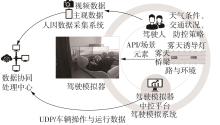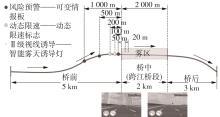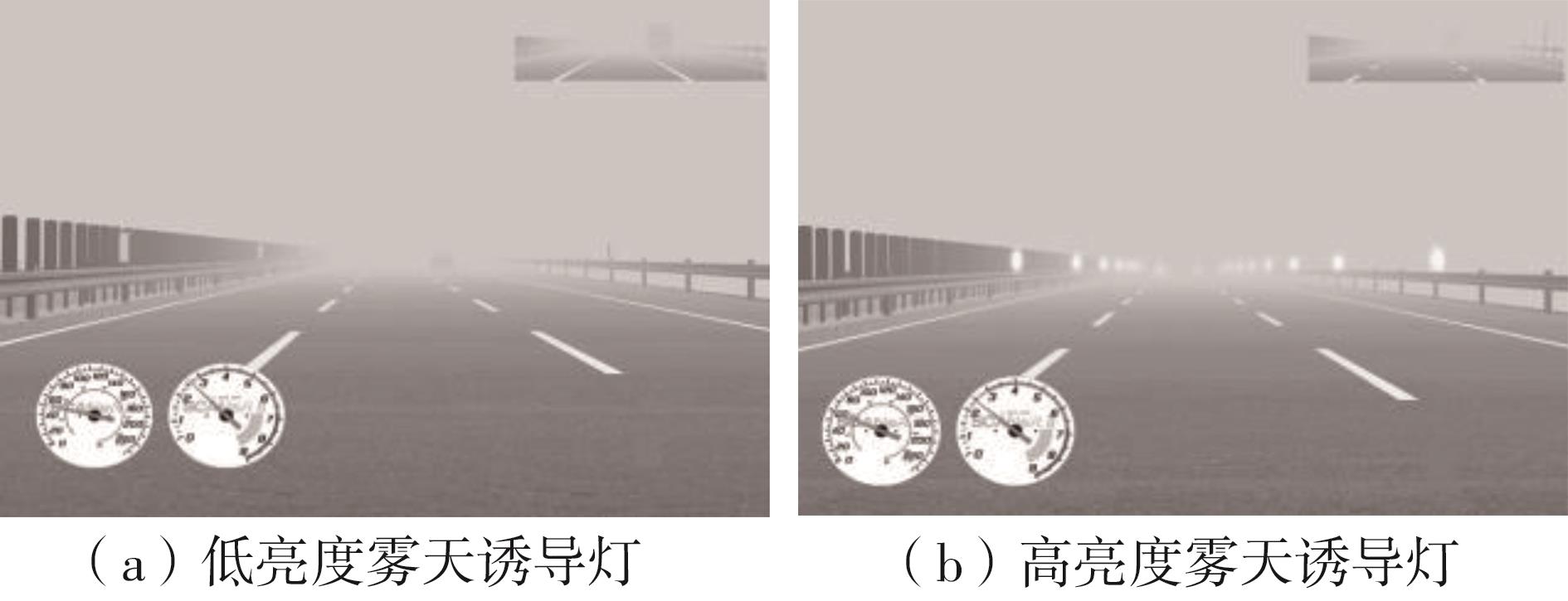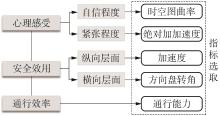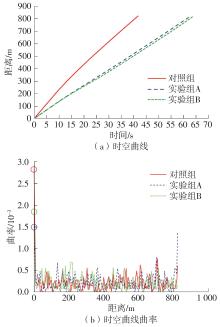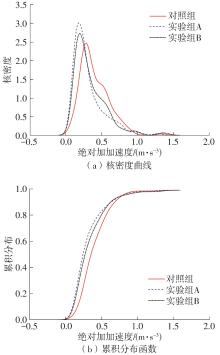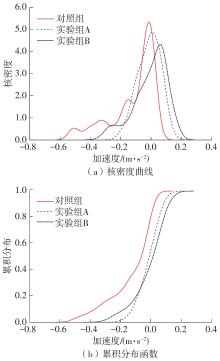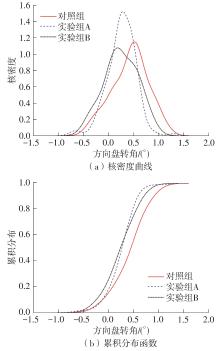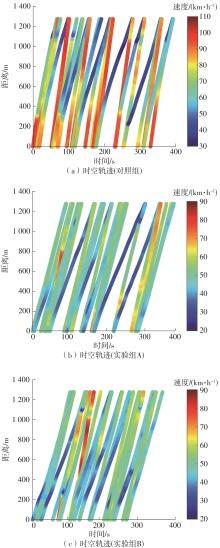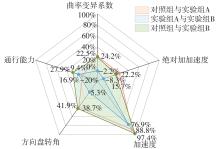Journal of South China University of Technology(Natural Science Edition) ›› 2024, Vol. 52 ›› Issue (11): 118-133.doi: 10.12141/j.issn.1000-565X.230757
Special Issue: 2024年智慧交通系统
• Intelligent Transportation System • Previous Articles Next Articles
Improvement Effectiveness of Active Warning Prevention and Control Strategy for Operation Risk on Foggy Bridges
DAI Yibo( ), ZHAO Xiaohua, BIAN Yang(
), ZHAO Xiaohua, BIAN Yang( ), ZHANG Jianhua
), ZHANG Jianhua
- Beijing Key Lab of Transportation,Beijing University of Technology,Beijing 100124,China
-
Received:2023-12-05Online:2024-11-25Published:2024-06-14 -
Contact:边扬(1980—),女,博士,副教授,主要从事交通安全、慢行交通、智能交通研究。 E-mail:bianyang@bjut.edu.cn -
About author:戴义博(1998—),男,博士生,主要从事交通安全、驾驶行为研究。E-mail:daiyibo525@163.com -
Supported by:the National Key R&D Program of China(2019YFB1600500)
CLC Number:
Cite this article
DAI Yibo, ZHAO Xiaohua, BIAN Yang, et al. Improvement Effectiveness of Active Warning Prevention and Control Strategy for Operation Risk on Foggy Bridges[J]. Journal of South China University of Technology(Natural Science Edition), 2024, 52(11): 118-133.
share this article
Table 2
Configuration parameters of multi-level differentiated bridge operation risk active warning prevention and control strategies in fog"
| 传统交通安全设施 | 风险预警(VMS文字提示信息) | 视线诱导 | 动态限速 (逐级)/(km·h-1) | |||||
|---|---|---|---|---|---|---|---|---|
| 1 km | 500 m | 50 m | 诱导 等级 | 工作 模式 | 亮度 | 频率/Hz | ||
注意桥头跳车 限速 注意不利气象 禁止超车 车距确认 | 前方 1 km能见度低 | 前方500 m能见度低,请减速慢行 | 前方能见度xx m,请谨慎驾驶 | I级 | 黄灯 常亮 | 500~7 000 cd/m2 | 100、80、60 100、80、60、40 | |
| II级 | 黄灯 闪烁 | 0.5 1.0 2.0 | ||||||
| III级 | 红灯 警示 | |||||||
Table 4
Statistical test results for indicators"
| 指标 | 均值(标准差) | P值 | |||
|---|---|---|---|---|---|
| C | A | B | 整体比较 | 成对比较 | |
| 绝对加加速度/(m·s-3) | 0.401(0.197) | 0.312(0.102) | 0.338(0.182) | 0.040** | C-A:0.011** A-B:0.452 C-B:0.072* |
| 加速度/(m·s-2) | -0.116(0.104) | -0.013(0.051) | -0.003(0.038) | 0.012** | C-A:0.000** A-B:0.402 C-B:0.000** |
| 方向盘转角/(°) | 0.432(0.096) | 0.265(0.059) | 0.251(0.068) | 0.000** | C-A:0.000** A-B:1.000 C-B:0.000** |
| 1 | 孙子秋,潘存书,徐进 .基于自然驾驶数据的跨江大桥小客车驾驶行为特征研究[J].交通信息与安全,2020,38(3):148-156. |
| SUN Ziqiu, PAN Cunshu, XU Jin .Driving behavior of passenger cars on river crossing bridge based on naturalistic driving data[J].Journal of Transport Information and Safety,2020,38(3):148-156. | |
| 2 | XIONG Z, ZHU J, ZHENG K,et al .Framework of wind-traffic-bridge coupled analysis considering realistic traffic behavior and vehicle inertia force[J].Journal of Wind Engineering and Industrial Aerodynamics,2020,205:104322/1-14. |
| 3 | 阚有俊 .基于BORA法的长大桥梁运营安全风险评估技术研究[J].安全与环境工程,2018,25(3):155-159,165. |
| KAN Youjun .Safety risk assessment technology for long span bridges operation based on BORA[J].Safety and Environmental Engineering,2018,25(3):155-159,165. | |
| 4 | 颜文华,陆建 .特大桥梁危险品运输风险分析及防范措施研究[J].交通标准化,2009(1):17-21. |
| YAN Wen-hua, LU Jian .Risk assessment of transporting dangerous articles on long-span concrete bridge and preventive measures[J].Transportation Standardization,2009(1):17-21. | |
| 5 | 吕惠卿,张湘伟,姜海波,等 .重要公路桥梁安全运营的动态监控及预警研究[J].广东工业大学学报,2011,28(1):16-19. |
| Hui-qing LÜ, ZHANG Xiang-wei, JIANG Hai-bo,et al .The study of safety running monitors and early-warning systems of highway bridge structures[J].Journal of Guangdong University of Technology,2011,28(1):16-19. | |
| 6 | CHEN S, ZHOU Y, WU J,et al .Research of long-span bridge and traffic system subjected to winds:a system and multi-hazard perspective[J].International Journal of Transportation Science and Technology,2017,6(3):184-195. |
| 7 | 尹紫红 .大型复杂多通道交通项目运营期风险管理研究[D].成都:西南交通大学,2013. |
| 8 | 邵长专 .斜拉桥风险评估研究与实践[D].重庆:重庆交通大学,2011. |
| 9 | 齐玉超 .长三角地区特大桥梁运营安全评价与预测研究[D].上海:上海交通大学,2012. |
| 10 | 郝景贤 .大跨径斜拉桥全寿命周期风险评估及对策研究[D].西安:长安大学,2017. |
| 11 | ZHAO X, YANG H, YAO Y,et al .Factors affecting traffic risks on bridge sections of freeways based on partial dependence plots[J].Physica A:Statistical Mechanics and Its Applications,2022,598:127343/1-16. |
| 12 | WANG J, YANG B, LIU J,et al .Safety speed assessment for driving in foggy environment based on visibility and vehicle brake performance[R].Detroit:SAE,2017. |
| 13 | 赵晓华,任贵超,陈晨,等 .不良天气下驾驶行为研究综述[J].交通信息与安全,2017,35(5):70-75,98. |
| ZHAO Xiaohua, REN Guichao, CHEN Chen,et al .A review on driving behavior under adverse weather conditions[J].Journal of Transport Information and Safety,2017,35(5):70-75,98. | |
| 14 | WANG K, ZHANG W, FENG Z,et al .Reasonable driving speed limits based on recognition time in a dynamic low-visibility environment related to fog — a driving simulator study[J].Accident Analysis & Prevention,2021,154:106060/1-8. |
| 15 | 张建华,赵晓华,欧居尚,等 .雾天桥梁可变限速值的效用评估及优化[J].华南理工大学学报(自然科学版),2024,52(1):127-138. |
| ZHANG Jianhua, ZHAO Xiaohua, Jushang OU,et al .Evaluation of utility and optimal of variable speed limit value for bridge in foggy condition[J].Journal of South China University of Technology(Natural Science Edition), 2024,52(1):127-138. | |
| 16 | PISANO P A, GOODWIN L C .Research needs for weather-responsive traffic management[J].Transportation Research Record,2004,1867(1):127-131. |
| 17 | 许先锋 .不良天气条件下高速公路安全控制研究[D].青岛:山东科技大学,2007. |
| 18 | WU Y, ABDEL-ATY M, PARK J,et al .Effects of real-time warning systems on driving under fog conditions using an empirically supported speed choice modeling framework[J].Transportation Research Part C:Emerging Technologies,2018,86:97-110. |
| 19 | 肖殿良,郭忠印,周子楚,等 .山区高速公路桥隧群运行风险预警系统[J].公路,2017,62(11):168-173. |
| XIAO Dianliang, GUO Zhongyin, ZHOU Zichu,et al .Operational risk warning system for mountain freeway bridge and tunnel clusters[J].Highway,2017,62(11):168-173. | |
| 20 | 朱岩,张洋,张丽红,等 .低能见度下高速公路主动诱导技术的应用[J].中国交通信息化,2016(6):83-85. |
| ZHU Yan, ZHANG Yang, ZHANG Lihong,et al .The application of active guidance technology on highways under low visibility[J].China ITS Journal,2016(6):83-85. | |
| 21 | LI C, FENG H, ZHI X,et al .Intelligent guidance system for foggy area traffic safety operation[C]∥Proceedings of 2011 14th International IEEE Conference on Intelligent Transportation Systems (ITSC).Washington,D C:IEEE,2011:428-432. |
| 22 | 李晓雷 .山区高速公路团雾段行车风险评估与视觉诱导研究[D].重庆:重庆交通大学,2018. |
| 23 | 赵晓华,陈雨菲,李海舰,等 .面向人因的车路协同系统综合测试及影响评估[J].中国公路学报,2019,32(6):248-261. |
| ZHAO Xiao-hua, CHEN Yu-fei, LI Hai-jian,et al .Comprehensive test and impact assessment for human factors of connected vehicle system[J].China Journal of Highway and Transport,2019,32(6):248-261. | |
| 24 | ZHAO X, CHEN Y, LI H,et al .A study of the compliance level of connected vehicle warning information in a fog warning system based on a driving simulation[J].Transportation Research Part F:Traffic Psychology and Behaviour,2021,76:215-237. |
| 25 | 赵晓华,鞠云杰,李佳,等 .基于驾驶行为和视觉特性的长大隧道突起路标作用效果评估[J].中国公路学报,2020,33(6):29-41. |
| ZHAO Xiaohua, JU Yunjie, LI Jia,et al .Evaluation of the effect of RPMs in extra-long tunnels based on driving behavior and visual characteristics[J].China Journal of Highway and Transport,2020,33(6):29-41. | |
| 26 | Van DER HORST R, De RIDDER S. Influence of roadside infrastructure on driving behavior:driving simulator study[J].Transportation Research Record,2007,2018(1):36-44. |
| 27 | 陈亦新,王雪松 .山区高速公路组合线形路段车道偏移行为[J].中国公路学报,2018,31(4):98-104. |
| CHEN Yi-xin, WANG Xue-song .Effects of combined alignments of mountainous freeways on lane departure[J].China Journal of Highway and Transport,2018,31(4):98-104. | |
| 28 | LERMAN J. Study design in clinical research:sample size estimation and power analysis[J].Canadian Journal of Anaesthesia,1996,43(2):184-191. |
| 29 | CHOW S C, SHAO J, WANG H,et al .Sample size calculations in clinical research[M].Boca Raton:CRC Press,2017. |
| 30 | 张文彤,董伟 .SPSS统计分析高级教程[M].北京:高等教育出版社,2013. |
| 31 | LIANG B, HE S, TÄHKÄMÖ L,et al .Lighting for road tunnels:the influence of CCT of light sources on reaction time[J].Displays,2020,61:101931/1-8. |
| 32 | REN S, HE K, GIRSHICK R,et al .Faster R-CNN:towards real-time object detection with region proposal networks[J].IEEE Transactions on Pattern Analysis & Machine Intelligence,2017,39(6):1137-1149. |
| 33 | 李海舰,赵国强,杨艳芳,等 .急刹预警作用下的车辆时空图特性[J].华南理工大学学报(自然科学版),2020,48(7):76-84. |
| LI Haijian, ZHAO Guoqiang, YANG Yanfang,et al .Characteristics of vehicle spatiotemporal diagram under the emergency braking warning[J].Journal of South China University of Technology (Natural Science Edition),2020,48(7):76-84. | |
| 34 | ZAKI M H, SAYED T, SHAABAN K .Use of drivers’ jerk profiles in computer vision-based traffic safety evaluations[J].Transportation Research Record,2014,2434(1):103-112. |
| 35 | OTHMAN M R, ZHANG Z, IMAMURA T,et al .A study of analysis method for driver features extraction[C]∥ Proceedings of 2008 IEEE International Conference on Systems,Man and Cybernetics.Singapore:IEEE,2008:1501-1505. |
| 36 | 赵晓华,迟景昊,樊兆董,等 .公路平交路口交通安全设施配套设置方法[J].中国公路学报,2017,30(11):122-128. |
| ZHAO Xiao-hua, CHI Jing-hao, FAN Zhao-dong,et al .Installation methodology of traffic safety devices at highway intersections[J].China Journal of Highway and Transport,2017,30(11):122-128. | |
| 37 | 张文彤 .SPSS统计分析基础教程[M].北京:高等教育出版社,2017. |
| 38 | YANG H, ZHAI X, ZHENG C. Effects of variable speed limits on traffic operation characteristics and environmental impacts under car-following scenarios:simulations in the framework of Kerner’s three-phase traffic theory[J].Physica A:Statistical Mechanics and Its Applications,2018,509:567-577. |
| 39 | CHANG X, LI H, RONG J,et al .Spatiotemporal characteristics of vehicle trajectories in a connected vehicle environment—a case of an extra-long tunnel scenario[J].IEEE Systems Journal,2020,15(2):2293-2304. |
| 40 | TSELENTIS D I, VLAHOGIANNI E I, YANNIS G. Driving safety efficiency benchmarking using smartphone data[J].Transportation Research Part C:Emerging Technologies,2019,109:343-357. |
| 41 | 樊兆董 .特长隧道特殊交通安全设施评估及优化方法研究[D].北京:北京工业大学,2018. |
| 42 | DING H, ZHAO X, RONG J,et al .Experimental research on the effectiveness and adaptability of speed reduction markings in downhill sections on urban roads:a driving simulation study[J].Accident Analysis & Prevention,2015,75:119-127. |
| [1] | BIAN Yang, ZHANG Yu, ZHAO Xiaohua, et al. Effect of Connected HUD Warning System on Driving Behavior for Pedestrian Crossing Events [J]. Journal of South China University of Technology(Natural Science Edition), 2024, 52(4): 114-125. |
| [2] | ZHAO Xiaohua, DONG Wenhui, LI Jia, et al. Influence Characteristics and Action Mechanism of Tunnel Traffic Signs Based on Driving Behavior [J]. Journal of South China University of Technology(Natural Science Edition), 2023, 51(4): 88-100. |
| [3] | YANG Liping, BIAN Yang, ZHAO Xiaohua, et al. Effects of Navigation Broadcast Wording Complexity on Driving Behaviors [J]. Journal of South China University of Technology (Natural Science Edition), 2021, 49(3): 139-148. |
| [4] | CHANG Xin, LI Haijian, RONG Jian, et al. Effect of the Tunnel Warning System on Traffic Capacity Based on Aggregated Spatiotemporal Characteristics of Vehicles [J]. Journal of South China University of Technology (Natural Science Edition), 2020, 48(9): 107-115,123. |
| [5] | LI Haijian, ZHAO Guoqiang, YANG Yanfang, et al. Characteristics of Vehicle Spatiotemporal Diagram Under the Emergency Braking Warning [J]. Journal of South China University of Technology (Natural Science Edition), 2020, 48(7): 76-84. |
| [6] | BIAN Yang, YU Jie ZHAO, Xiaohua, et al. Research on the Comprehensive Influence of Navigation BroadcastWording on Driving Behavior [J]. Journal of South China University of Technology (Natural Science Edition), 2020, 48(11): 30-37,54. |
| [7] | Li He- xi Shi Yong- hua Wang Guo- rong. Visual Guidance of Welding Robot Using SVR- Jacobian Estimator [J]. Journal of South China University of Technology (Natural Science Edition), 2013, 41(7): 19-25. |
| Viewed | ||||||
|
Full text |
|
|||||
|
Abstract |
|
|||||
